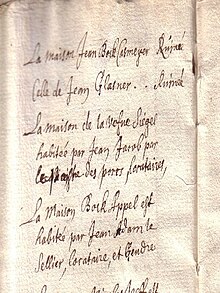Writing material
Unglazed pottery shards were used almost as a kind of scratch paper, as ostraka, for tax receipts, and, in Athens, to record the individual nominations of Greek leaders for ostracism.On the Indian subcontinent, principal writing media were bhurjapatra made from birch bark, and palm leaf manuscript.Palm leaf manuscript was also the major source for writing and painting in South and Southeast Asian countries including Nepal, Sri Lanka, Burma, Thailand, Indonesia and Cambodia.In China, early writing materials included animal bones, later silk,[9] bamboo and wooden slips,[10] until the 2nd century when paper was invented.[citation needed] Cai Lun used old rags, hemp, tree bark, and fishing nets to develop a method of paper-making fundamentally similar to that still used today.The craft of paper-making reached Spain in the twelfth century, and at subsequent hundred-year intervals arrived in Italy, Germany, and England.James Whatman and John Baskerville (1706–1775) invented a method for producing perfectly smooth paper using a fine wire mesh that left no lines from the mould on the page.



suitable instrumentssymbolicBuilding materialscave paintingstally sticksAnimal hidesbirch barkcurse tabletsMiddle Kingdom of EgyptpapyrusParchmentwood-pulp paperarchivesclay tabletscuneiform scriptStone tabletswax-covered wooden tabletsostrakaostracismpalm leaf manuscriptbamboo and wooden slipsCai LunJames WhatmanJohn BaskervilleUniversity of California, BerkeleyWritingTrema micranthaFicus aureaBetulaFolding-book manuscriptStreblus asperBroussonetia papyriferaOla leafCorypha umbraculiferaPalm leafBorassusCyperus papyrusVellumIntaglioStampingOracle bonePhotographic filmGeoglyphPetroglyphClay tabletWax tabletTextile printingSilk textElectronic paperScreenSkywritingNotebookElectronic mediaHu/Shaku (baton)InscriptionBas-reliefManuscriptPalimpsestMicroformScrollWriting systemsHistory of writingList of writing systemsWritten language